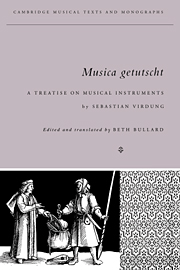A note on the translation
Published online by Cambridge University Press: 14 August 2009
Summary
Sebastian Virdung wrote Musica getutscht in his mother tongue, a language known today as Early New High German (Frühneuhochdeutsch). Virdung's particular use of this language falls between two well-researched linguistic eras: that of its precursor, Middle High German, and that of its more standardized offspring, the Early New High German cultivated by Martin Luther and his literary contemporaries in the decades following publication of Musica getutscht. Virdung's German presents difficulties to the modern reader. These arise in connection with archaic vocabulary and grammatical constructions, as well as colloquial inconsistencies and orthographic variety. Then too, the convoluted ordering of elements in some of the more lengthy sentences, especially when further obscured by unreliable punctuation and capitalization, makes necessary “much effort and careful examination” (vil müe und übersehens) to quote Virdung himself (sig. A4v, p. 100 below).
In this English version of Musica getutscht I have followed the original text very closely, electing where feasible to render the German into English as accurately as possible per verbum rather than more casually per sensum. To this end I have consulted coeval dictionaries to check meanings of virtually the entire vocabulary employed in the treatise. I hope thus to have captured some of the flavor of Virdung's language and to have retained subtle insights into modes of thought characteristic of his time and place.
In preparing the edition of this work I have found the modal auxiliary verbs to be the most problematic to translate.
- Type
- Chapter
- Information
- Musica GetutschtA Treatise on Musical Instruments (1511) by Sebastian Virdung, pp. 91 - 94Publisher: Cambridge University PressPrint publication year: 1993



